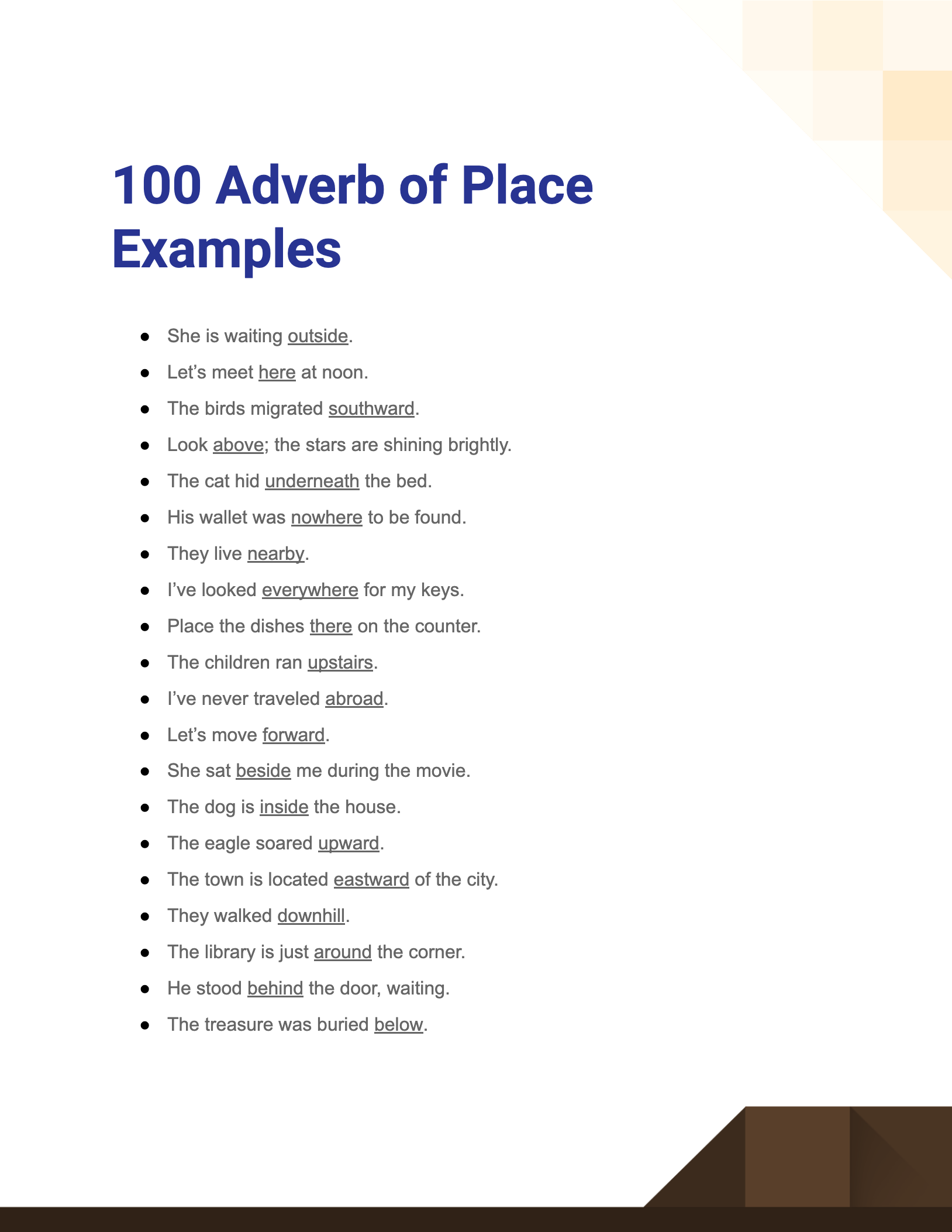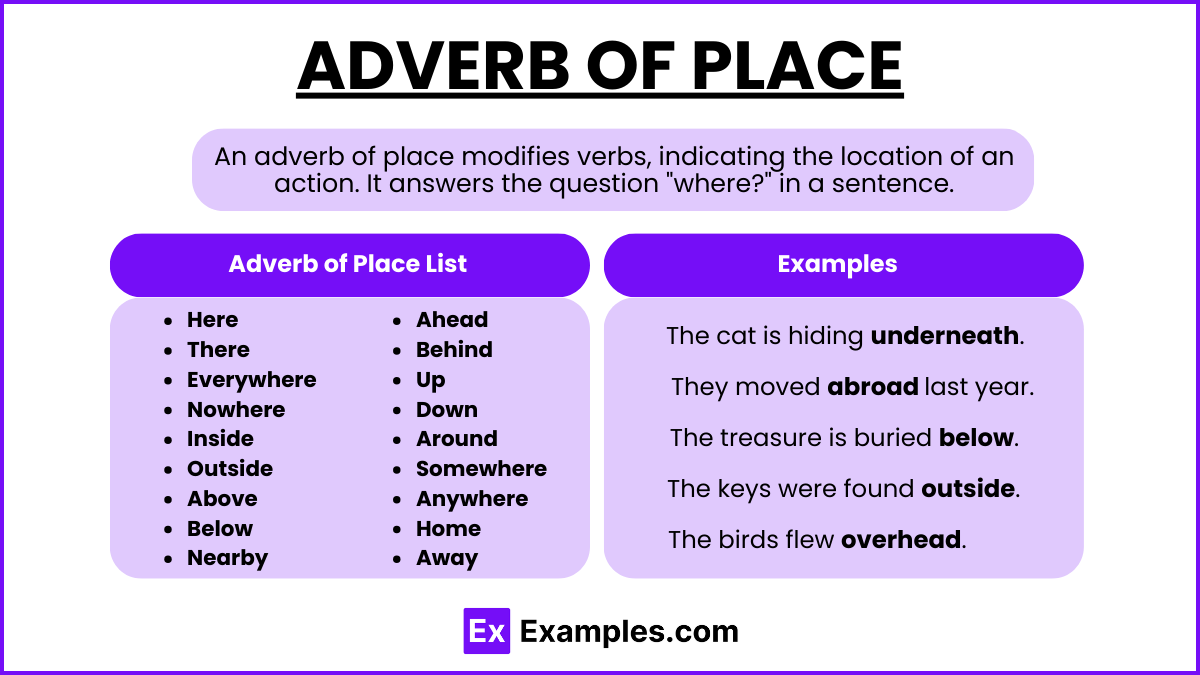99+ Adverb of Place Examples
Unearth the nuances of ‘place’ in your sentences with our comprehensive guide on Adverb of Place Examples. Navigating the landscape of language, this guide elucidates how to adeptly use these pivotal adverbs, enriching your prose and communication. From the basics to pro-level tips, immerse yourself in illustrative adverb examples that promise to anchor your understanding. Elevate your writing by pinpointing the ‘where’ with precision and flair. Dive in and find your linguistic direction!
What is an Adverb of Place? – Definition
An Adverb of Place, often referred to as a locative adverb, provides information about the location of an action or the direction and distance involved in that action. It answers the questions like “Where?”, “In what direction?”, or “How far?”. These adverbs give context to the action, helping to paint a clearer picture of a scene or situation in the reader’s or listener’s mind.
Example of Adverb of Place
- “The children are playing outside.”
In this sentence, “outside” is the adverb of place, indicating where the action (playing) is taking place. Other examples of adverbs of place include: Here, everywhere, nowhere, anywhere, up, down, near, far, and many more.
Adverbs of Place List
| Here | There | Everywhere |
| Nowhere | Inside | Outside |
| Above | Below | Nearby |
| Far | Ahead | Behind |
| Up | Down | Around |
| Somewhere | Anywhere | Home |
| Away | Out | In |
| Upstairs | Downstairs | Overhead |
| Underground | Abroad | Back |
| Off | Over |
100 Adverb of Place Examples

Journey through the intricate landscape of English language with these 100 vivid Adverb of Place examples. From the commonplace to the nuanced, these sentences are curated to illuminate the ‘where’ in your narrative, providing both context and color.
- She is waiting outside.
- Let’s meet here at noon.
- The birds migrated southward.
- Look above; the stars are shining brightly.
- The cat hid underneath the bed.
- His wallet was nowhere to be found.
- They live nearby.
- I’ve looked everywhere for my keys.
- Place the dishes there on the counter.
- The children ran upstairs.
- I’ve never traveled abroad.
- Let’s move forward.
- She sat beside me during the movie.
- The dog is inside the house.
- The eagle soared upward.
- The town is located eastward of the city.
- They walked downhill.
- The library is just around the corner.
- He stood behind the door, waiting.
- The treasure was buried below.
- She gazed downward.
- We moved onward to the next challenge.
- The village lies northward.
- Place the book there on the shelf.
- The café is right over there.
- Can you step aside?
- He journeyed overseas for the conference.
- The train headed south.
- The ball rolled backward.
- The castle stands yonder on the hill.
- Keep the flowers here.
- The plane flew overhead.
- I found it beneath the couch.
- The campsite is upstream.
- They went downtown for the concert.
- The ship sailed westward.
- Look ahead for any obstacles.
- We camped downstream from the waterfall.
- The kids are playing upfield.
- The treasure map points inward to the island’s center.
- The museum is located downstreet.
- The climbers progressed upwardly.
- The cat went homeward after its adventure.
- The lost phone was elsewhere.
- The deer darted sideways.
- The boat drifted seaward.
- The storm moved inland.
- The kite flew skyward.
- The car is parked right here.
- The old church is farther down the road.
- He gazed outward, looking at the horizon.
- They’re heading up north for the summer.
- The wind blew the leaves around.
- The forest lies beyond those mountains.
- He walked across the bridge.
- The ball bounced back.
- The owl perched above the tree.
- The children wandered off the path.
- She moved near the window to see better.
- The island is located southwardly.
- The car drove past the school.
- She lives down road.
- I’ll be right here.
- The team is training downfield.
- The stars are up above.
- The horse galloped away.
- The hut stands aloof from the village.
- The toy is under the table.
- The plane landed downwards.
- I’m headed home now.
- The village is further up the valley.
- The ball is within that box.
- He went through the tunnel.
- The birds flew upward into the sky.
- The ship went downward after hitting the iceberg.
- They ran across the field.
- The sun set behind the mountain.
- The dog sleeps besides my bed.
- The fish swam downwards.
- The plane flew eastward.
- Keep the shoes outside.
- The car is parked upfront.
- The shop is just down the lane.
- The ball went out of the stadium.
- I left my bag there.
- The notebook is right on the table.
- She’s waiting downstairs.
- The cat sat alongside the dog.
- The boat floated onward.
- The eagle soared high in the sky.
- I searched for it everywhere.
- The sound came from below.
- The kite is somewhere in the sky.
- The treasure is hidden underground.
- He went upwards to the roof.
- The village is situated downvalley.
- The tower stands aloft.
- The school is uphill.
- The tree fell downward.
- The rabbit jumped sideward.
Adverb of Place Examples Sentences
Venture into the realm of descriptive linguistics with these Adverb in sentences. By pinpointing locations, these adverbs offer readers a GPS to the action, grounding stories and events in specific settings.
- She placed the vase beside the window.
- The squirrel scampered above on the branches.
- We will camp uphill tonight.
- The letters are inside the drawer.
- The plane headed west.
- The owl hooted overhead during the night.
- We strolled along the riverbank.
- The island is farther west.
- The shadow lurked behind the building.
- The sun rises eastward.
Adverb of Place Exercise Examples
Sharpen your understanding of adverbs of place with these exercises. By filling in the blanks or identifying the adverbs, you’ll hone your grasp on the ‘where’ in your statements.
- The cat is hiding _____ the couch.
- A. beneath
- B. beside
- C. around
- D. above
- We decided to travel _____ for our holiday.
- A. abroad
- B. nearby
- C. inside
- D. upstairs
- The stars shine brightly _____.
- A. above
- B. below
- C. inside
- D. around
- Place the books _____ that shelf.
- A. on
- B. beneath
- C. behind
- D. near
- The birds flew _____ the rainbow.
- A. over
- B. under
- C. through
- D. around
- They walked _____ the bridge at sunset.
- A. across
- B. alongside
- C. under
- D. beyond
- Her house is located _____ the post office.
- A. behind
- B. next to
- C. in front of
- D. across from
- The treasure is buried _____.
- A. below
- B. within
- C. underneath
- D. beside
- I will meet you _____ the cinema.
- A. in front of
- B. behind
- C. inside
- D. near
- The dog chased its tail _____.
- A. around
- B. above
- C. near
- D. beside
Adverb of Place Examples with Answers
A perfect fusion of challenge and clarity, these examples come paired with answers. This setup offers a ready reckoner, allowing you to gauge your understanding of adverbs of place instantly.
- The birds nested above our porch. (above)
- You’ll find the town beyond those hills. (beyond)
- The ship sailed westwards. (westwards)
- The kite got stuck between the trees. (between)
- Place the gifts underneath the Christmas tree. (underneath)
- The deer ran towards the forest. (towards)
- The ball rolled beyond the fence. (beyond)
- The airplane flew over the city. (over)
- We camped beside the lake. (beside)
- The kids are playing near the playground. (near)
How to Use the Adverb of Place?
Adverbs of Place essentially describe where the action happens. Whether it’s in the air, on the ground, close by, or far away, these adverbs give clarity to the position or direction of an action. Here’s how to use them effectively:
- Position and Location: Adverbs of place provide specific details about where an action takes place.
- She is waiting outside.
- The cat slept beneath the tree.
- Direction and Distance: Some adverbs describe where the subject is headed or the distance involved.
- The bird flew upward.
- She lives two blocks away.
- Adding Emphasis: Often, placing the adverb at the beginning of the sentence can emphasize the location or direction.
- Here is where we’ll set up camp.
- Downstairs, the party was in full swing.
- Avoid Redundancy: Ensure that the sentence doesn’t become redundant with the use of adverbs of place.
- Correct: She went outside.
- Incorrect: She went outside out.
- Compound Words: Some adverbs of place are compound words. Make sure you’re familiar with their correct usage.
- The book is inside (not in inside).
- In Questions: Adverbs of place are often used in questions when inquiring about the location of something or someone.
- Where is the nearest hospital around here?
Tips for Using Adverb of Place
- Start Simple: Begin by using common adverbs like above, below, here, and there, before diving into more complex ones.
- Context is Key: While adverbs of place can often stand alone, it’s vital to ensure they are supported by context so readers or listeners can understand the location or direction clearly.
- Sentence Variety: Use adverbs of place at different positions in your sentences – beginning, middle, or end – to introduce variety in your writing.
- Less is More: While it’s tempting to use several adverbs for precision, sometimes it’s best to use just one strong, specific adverb rather than crowding your sentence.
- Pair with Adverbs of Manner: Sometimes, pairing an adverb of place with an adverb of manner can give a clearer picture of an action.
- He swiftly ran upwards.
- Avoid Ambiguity: Choose your adverbs wisely so that they don’t introduce ambiguity.
- Ambiguous: He saw the man below with a telescope.
- Clearer: With a telescope, he saw the man below.
- Use Physical Gestures in Conversation: When speaking, pair your adverbs of place with gestures. Pointing, gesturing upwards or downwards, or using your hands to indicate direction can make your meaning clearer.
- Read and Practice: The more you read diverse content, the more you’ll encounter adverbs of place being used in various contexts. This will enhance your understanding and usage.
- Feedback Loop: When writing, always ask someone to read your content. They can provide feedback on whether the adverbs of place you’ve used make sense or if they’ve made the narrative confusing.
- Constant Learning: The English language is ever-evolving. New words get added while some old ones go out of style. Always keep updating your knowledge.
Understanding and mastering adverbs of place can significantly enrich your writing and speaking, providing clarity and creating vivid imagery for your audience. Happy writing!



